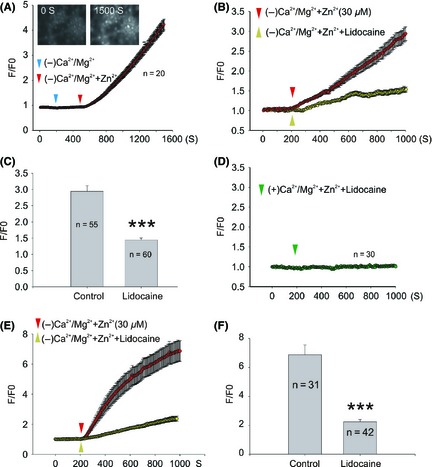Figure 4.

Lidocaine inhibits TRPM7‐mediated [Zn2+]i accumulation in cortical neurons and HEK‐293 cells overexpressing TRPM7 channels. (A) Representative images (inset images) and traces showing FluoZin‐3 fluorescence change in normal ECF (0–200S), Ca2+/Mg2+ deprivation ECF (200–500S), and Ca2+/Mg2+ deprivation with zinc addition ECF (500–1500S). (B) Time‐dependent change of FluoZin‐3 fluorescence with (yellow triangle) or without (red triangle) 10 mM lidocaine. Neurons were treated with normal ECF before the activation of TRPM7 by Ca2+/Mg2+ deprivation. Each trace represents an average fluorescent intensity from randomly selected cells from three to four independent experiments. (C) Summary bar graph inferred from B showing the normalized fluorescence intensity at the 1000 S time point (***P < 0.001). (D) The effect of 10 mM lidocaine on the basal FluoZin‐3 fluorescence. (E) Time‐dependent changes of FluoZin‐3 fluorescence with (yellow triangle) or without (red triangle) 10 mM lidocaine in HEK‐293 cells. HEK‐293 cells were treated with normal ECF before TRPM7 activation by Ca2+/Mg2+ deprivation. Each trace represents an average fluorescent intensity from randomly selected 31–42 cells from three to four independent experiments. (F) Summary bar graph represents the normalized fluorescence intensity at the 1000 S time point (***P < 0.001).
